Plants with large leaves
Compositions of houseplants with large leaves look beautiful and unusual. They will easily decorate any interior, and thanks to the impressive size of the leaves, they release additional oxygen and successfully purify the air in the apartment.
Check out the list of plants that are worth planting at home.
Indoor bananas
In addition to huge leaves, bananas are also the tallest, so I decided to start with it. Its size is impressive and will not leave your guests indifferent. A banana plant usually has from 6 to 20 oval-shaped leaves, which are located in bunches. The size of the leaves can reach 3 meters in length and up to 0.5 meters in width.
In addition to impressive sizes, they have beautiful flowers that are collected in brushes. But in order for the banana to please with its flowering, it is important to strictly follow the care recommendations.
Bananas prefer temperatures between 21-27 degrees in summer and 17-20 in winter. Since they are of tropical origin, it is important to provide bright diffused light and high humidity. It is also important to water and spray it often, and wipe it once a week.
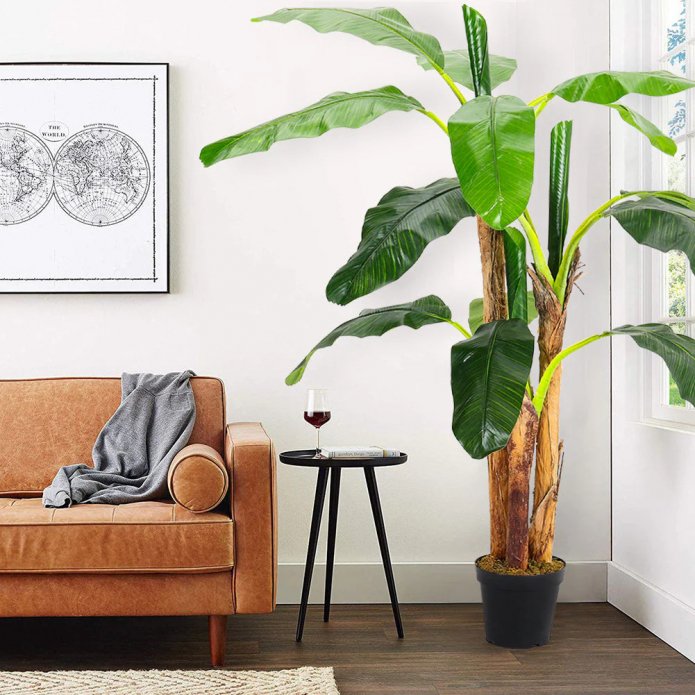
Dracaena
They come in several varieties and can grow up to 2 m in height. Dracaena has large long leaves, but at the same time they are decorated with multi-colored stripes – white or yellow. Red edging is also characteristic.
Dracaena prefers northern regions and grows best at room temperature. The substrate for it should be constantly slightly moist.
Winter watering should be reduced, but do not forget about spraying the plants, as the air in the room should be humid. For compliance with these requirements, the plant will thank you with impressive growth and strong stems with a decorative crown.
An alternative plant is nolina, it is distinguished by spacious spreading foliage and a large bulb.
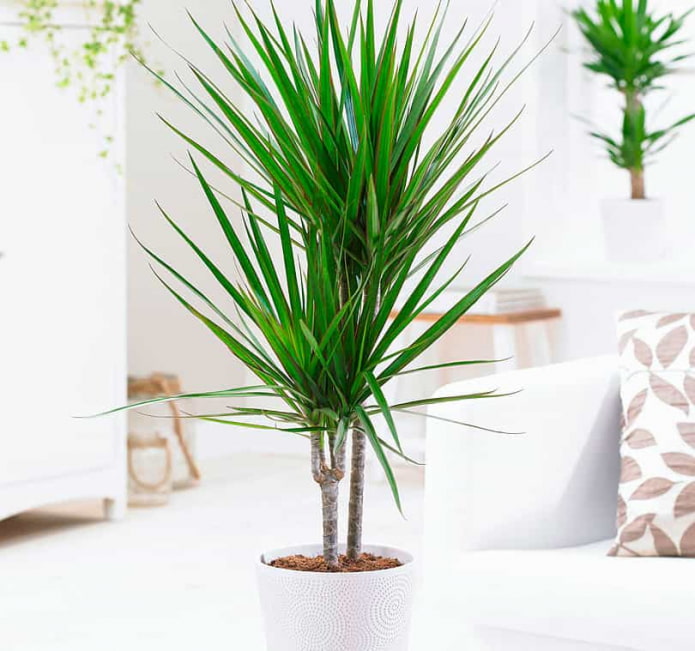
Palms
A little tropical mood in your home? Among the large plants, potted palms predominate, presented in many varieties, for example, washingtonia. Among them, it is worth noting the exquisite chamedorea, which in nature grows up to 4 meters, and in its homeland – half as much. It does not have so much large leaves as spreading branches, arranged in the form of a plume. At first they are dense, but over time they become thinner and diverge to the sides. Chamedorea is also strewn with small yellow fruits in the form of beads.
Another lush palm that can be grown in a bright place is chrysalidocarpus (dypsis). It has similar requirements and reaches almost the same height as the coral palm. After a few years, its stem becomes woody and new greenery begins to grow from it.

Canary Island Date Palm
The Canary Island Date Palm, also known as the Canary Island Date Palm, is a variety that is characterized by a very fast growth rate. Large potted representatives of this species grow well in bright and sunny places.
However, it should be remembered that at some point the space in the house or apartment will become too small for them, and the plant will have to be moved outside. These large specimens require abundant watering in the summer, light watering in the winter (rest period) and regular fertilization of the soil. The best substrate is cultivated soil with an admixture of humus substrate.
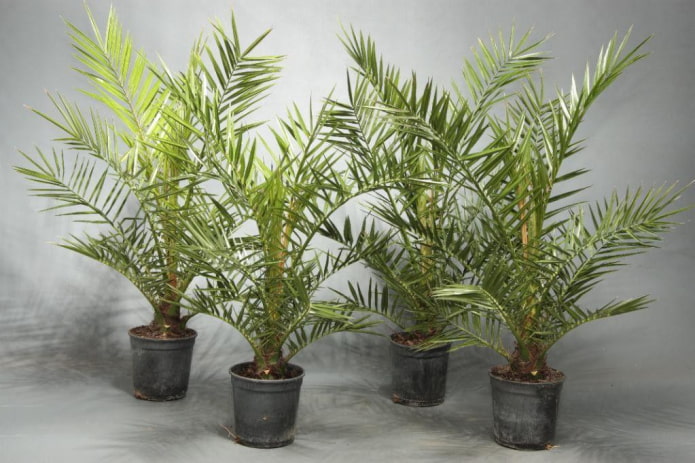
Monstera
This is certainly one of the most fashionable potted plants of recent years. It is a fast-growing large-sized plant, the leaves of which have a characteristic heart shape and are covered with holes and cracks. These cracks on large leaves are uneven and extremely decorative. However, they require support – the stems grow so quickly that without support they can break.
See the list of plants for the hallway.
The height of the Monstera can reach 5 meters. These large potted plants also form additional hanging vines, adding an exotic character to the Monstera. Prefers a warm place (room temperature is enough, but not below 15 degrees Celsius). It likes a moist substrate and regular moisture. It is best placed in a semi-shaded place.
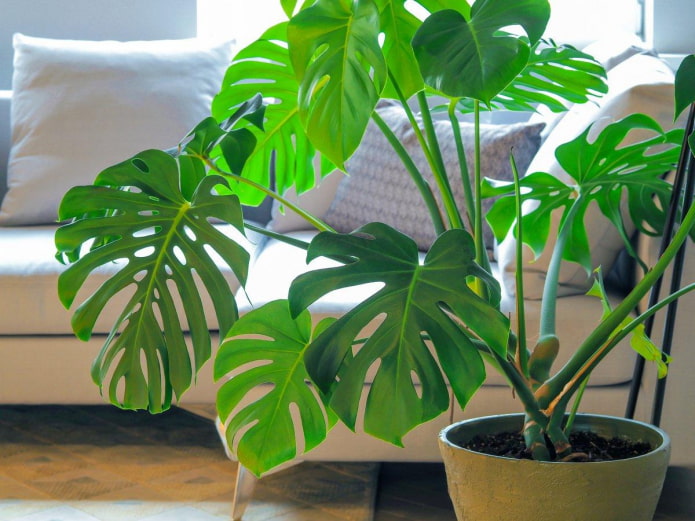
Ficus
Ficus elastica is a large-leaf variety of ficus grown indoors. Ficus with white-green or dark green glossy leathery leaves grows upward, reaching 2 meters in width and 3 meters in height.
Ficus is not very demanding to growing conditions. Prefers eastern or western exposure with direct sunlight, a minimum temperature of 10 degrees Celsius and moderate watering. An alternative is croton (codiaeum), which has a beautiful decorative appearance and is unpretentious in care.

Water pachira
This large plant cannot be left out of our list. Pachira grows up to 1 meter in height, but has impressive foliage. When growing, it requires some effort, mainly shaping. Due to its rather thin and flexible trunk, plant not one specimen, but even three next to each other and connect them by braiding the stems.
It is important that the water pachira stands in a sunny place, otherwise it withers and may even shed its leaves. It needs to be replanted annually and watered abundantly in the summer. In return, it will repay you with magnificent leaves – palmate, dark green and glossy.
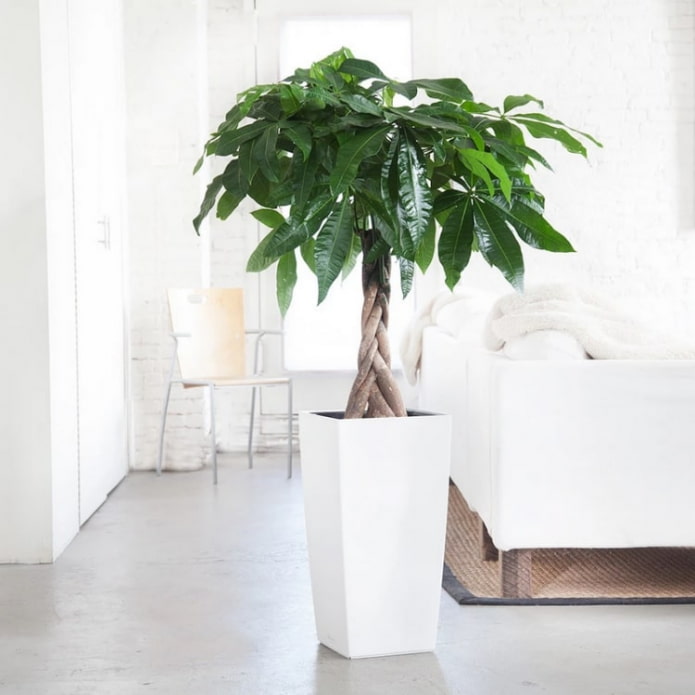
Philodendron
At home, it grows to large sizes and is especially notable for its large decorative leaves. Philodendron comes in the form of small shrubs or vines. It requires frequent watering in summer, winter watering should be reduced to once every 7 days.
It cannot be kept in a room where the temperature is below 10 degrees Celsius. It requires fertilizing 2-3 times with compost and perlite – especially during the period of intensive growth. Alternatives are dieffenbachia and fatsia.
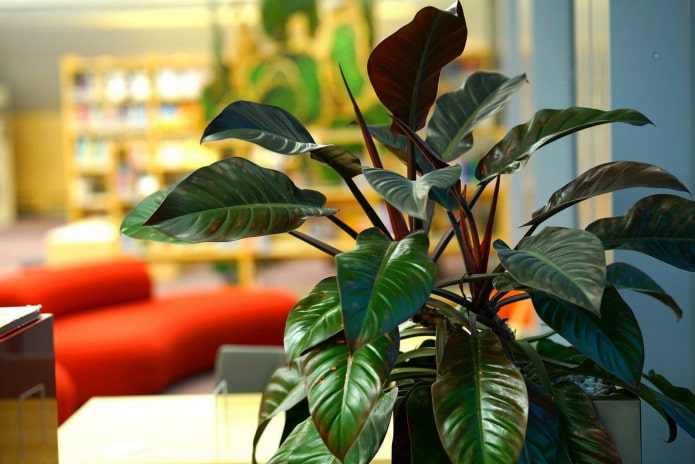
The Tallest Plants
With the help of tall indoor plants, it is easy to decorate the interior and create a natural atmosphere in any room. Of course, for small apartments with low ceilings, this is not the best option. But there are places where you need tall plants to easily move your eye around the room and catch a glimpse of calming greenery. Hibiscus is a popular choice, but we’ve put together a list of some of the more interesting ones.
Euphorbia ingens
Scientific name: Euphorbia ingens
Height: 10 to 23 feet.
So, let’s start with… a cactus? Yes, you guessed it! Euphorbia ingens is one of the best tall houseplants that is low maintenance and beautiful to look at. This tall cactus is native to South Africa and prefers full sun, so place it in a south-facing location with plenty of direct sunlight.
Water your African chandelier twice a month after the soil has completely dried out from the last watering. If you don’t have a spot for full sun, it’s time to consider another option that requires less lighting. An alternative is yucca, which does not have such a long stem and grows as a bush, but is just as easy to care for both in winter and summer.
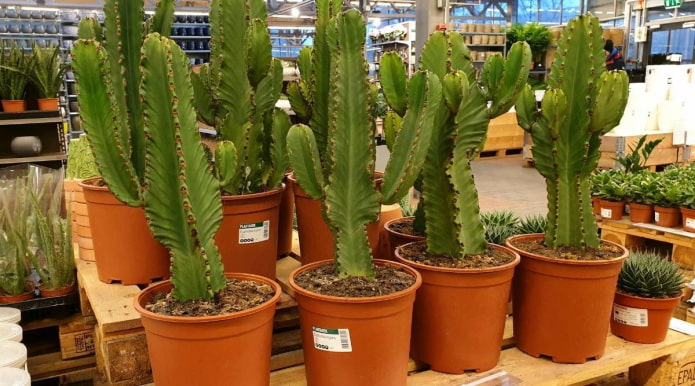
Ficus Cyathistipula
Scientific name: Ficus cyathistipula.
Height: up to 4 m.
The ficus has beautiful, hardy evergreen leaves. Although its foliage is noteworthy, this plant also produces white flowers in early spring. Therefore, keep it in a place where it receives direct sunlight to encourage flowering. This tall houseplant loves lots of water.
Keep the soil of yours moist and check it regularly. Ficus loves moisture, so it should be sprayed daily with purified water. Another large brother is the Ficus benjamina. It grows to a large size and has a crown like a tree. An alternative plant can be any citrus tree.
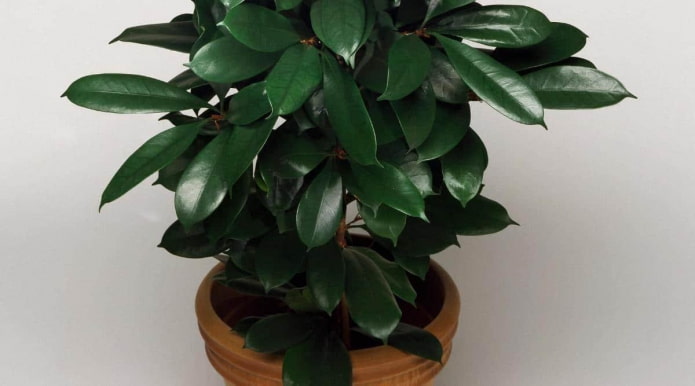
Bamboo
Scientific name: Bambusoideae
Size: 1.5 to 2.5 m tall
Bamboo has light green leaves and long stems. This easy-to-propagate plant is perfect for filling a spacious living room with life. Gardeners love to keep indoor bamboo in their homes, as it is considered a symbol of health and good luck in some cultures.
Water the bamboo with room temperature water once a week and place it in a place where it receives direct sunlight for most of the day, as it needs a lot of light. Bamboo prefers to be away from cold and drafts.
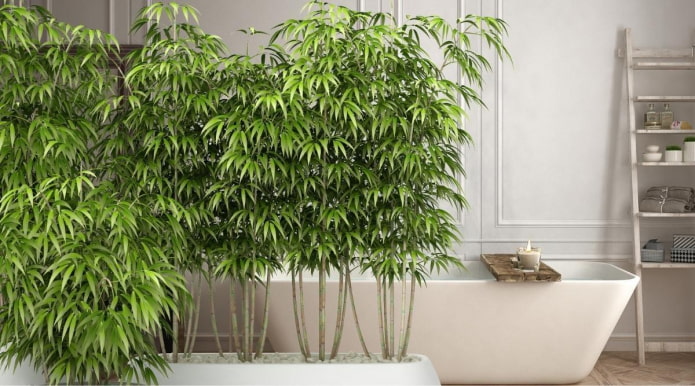
Strelitzia
Scientific name: Strelitzia
Height: up to 2 m.
Strelitzia is a unique plant that is worth adding to your garden. This tropical flowering plant has striking dark green leaves and a unique flower that resembles a colorful bird, which is what makes it so popular.
Strelitzia thrives when given adequate moisture. Water it every one to two weeks or when the soil is completely dry. This plant tolerates almost any lighting, but prefers full sun for the most colorful flowering.
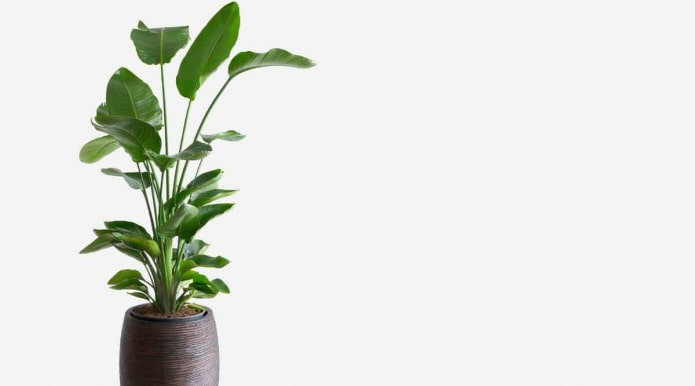
Schefflera Arborescens
Scientific Name: Schefflera arboricola
Size: 1.4 to 1.8 meters tall
Scheffleras are popular in home gardens. They can have bicolor leaves with a rich green color and a lighter, bright green interior. Since they come from humid areas, you can mist them frequently with room temperature water to simulate that environment.
Very sensitive to drafts. An alternative flower would be croton. It is equally easy to care for and has high ornamental value.

Yucca
Scientific name: Yucca.
Height: up to 2-2.5 meters.
This woody plant is native to South America. It prefers good lighting and moderate temperatures in the summer and cooler in the winter. Loves abundant watering in hot weather, but is not afraid of drought at all. Regular feeding is recommended approximately once every 2 weeks in spring and summer, and is not necessary in winter and autumn.
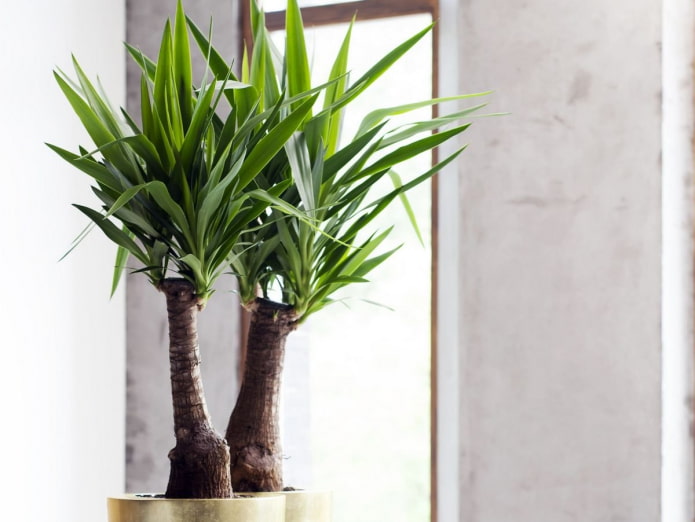
A selection of shade-loving plants
Indoor plants that can grow in low light conditions are valuable for arranging “difficult” spaces. They can be grown in dark rooms (for example, with a window facing north), in a bathroom with a small window, in a hallway, on a staircase, or away from a window. Most of them are well-known species that are often found in apartments.
Zamioculcas
Zamiculcas zamiolifolia is said to be an iron plant – it is difficult to kill. In practice, this is possible if the plant is overwatered. Excessive moisture causes the leaves to turn yellow, rot at the base and die. However, in this case, it can be trimmed and the root ball dried. Then there is a chance that the zamioculcas has budded off from the rhizome. The main thing is to water sparingly.
The plant tolerates shade well, retaining its color and shine. It grows more slowly in the shade. The plant usually grows up to 150 cm. Zamioculcas has elliptical or ovoid, glossy leathery leaves growing on fleshy stems that are round in cross-section.
This species adds a certain exoticism to the interior. In the wild, zamioculcas is found in Tanzania and on the island of Zanzibar.
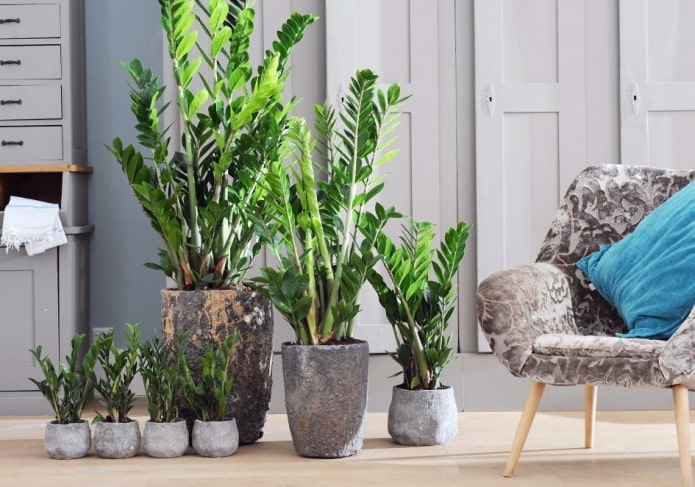
Spathiphyllum
Spathiphyllum is an ornamental plant with beautiful flowers. It feels very good in partial shade and shade. It can be grown in dark bathrooms (with a window), as well as on stairwells. It does not like strong sunlight, prefers diffused refreshment and high humidity.
It is recommended to water moderately, but do not use leaf polish. The plant usually reaches 20-50 cm in height. Forms a dense mound of lanceolate, pointed, glossy leaves. Flowering times may vary – in fact, the plant can bloom all year round. The plant forms bright white inflorescences (spicate pseudanthium).
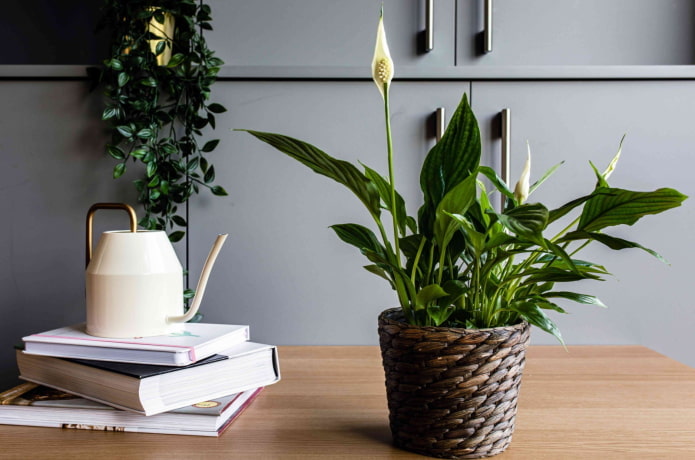
Sansevieria trifasciata
Sansevieria trifasciata, which is commonly called “mother-in-law’s tongue”, is also called a steel plant, for its unpretentiousness in care, and can suffer mainly from overzealous watering. Also, do not pour water directly into the outlet. Unlike the above-mentioned species, it tolerates partial shading well, but also sunny places.
Full shading is not recommended – the plant becomes weak and brittle. It is not very susceptible to diseases and pests. Sansevieria usually grows up to 75 cm in height (maximum up to 120 cm). There are also miniature varieties. The decorative features of the plant are sword-shaped, hard, sharp leaves with a marbled pattern (light and dark green).
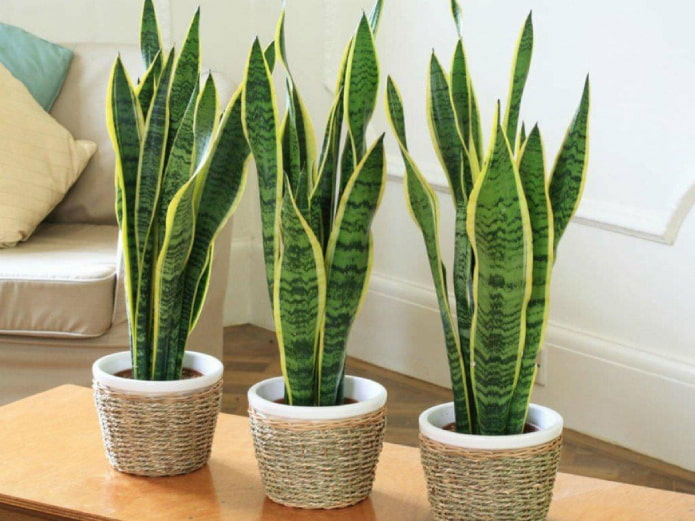
Common ivy
Hedera helix can be a capricious plant when it comes to watering. Excess moisture leads to yellowing and falling of foliage, even short-term drought – to browning and drying out. It requires regularity – the substrate should be constantly maintained in a moderately moist state.
However, this species feels good in partial shade and partial shade. Common ivy produces creeping stems densely covered with lobed leaves. The color and “pattern” of the lobes depends on the variety. Specimens growing in the shade have slightly smaller and less colorful (less contrasting) leaves.
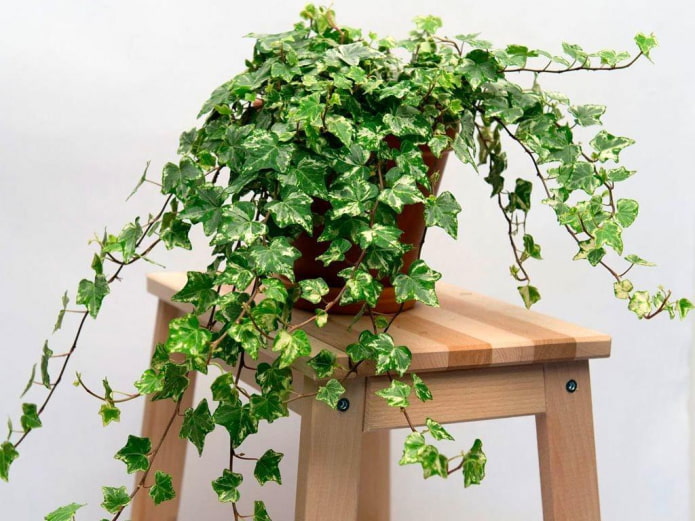
Tradescantia zebrina
Tradescantia zebrina is easy to grow due to its low maintenance requirements and spectacular color. It is one of the most popular low-maintenance houseplants. Tradescantia loves places with plenty of diffused light.
It feels good in shady places, but the stems are more fragile and the leaves are less colorful. Cultivation in these conditions is still possible. The substrate should be constantly moist, but not wet.
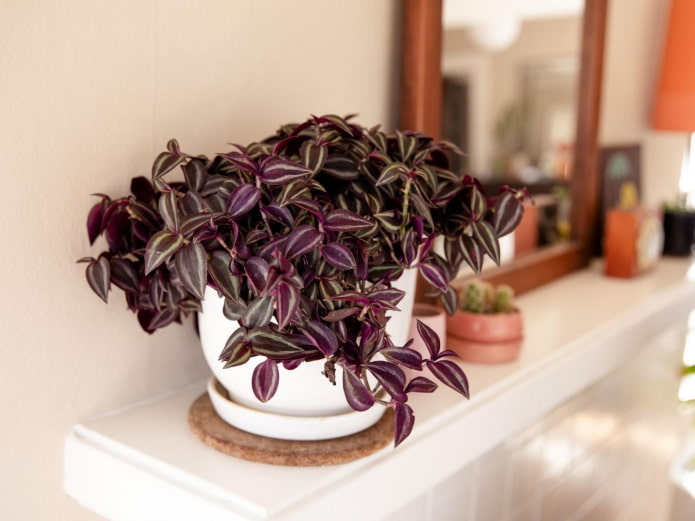
Unpretentious giants
Plants that reach large sizes, but do not require special care and difficult conditions – a dream of novice gardeners.
European olive
The European olive tree is a potted tree that looks clean and fresh indoors. This large tree grows best in full sun. The dark green leaves of this tree are small and oblong.
The European olive is drought-resistant, so when growing indoors, you need to let the soil dry out. Water the olive once a month to completely saturate the soil with moisture. Then let it dry out completely before watering again.
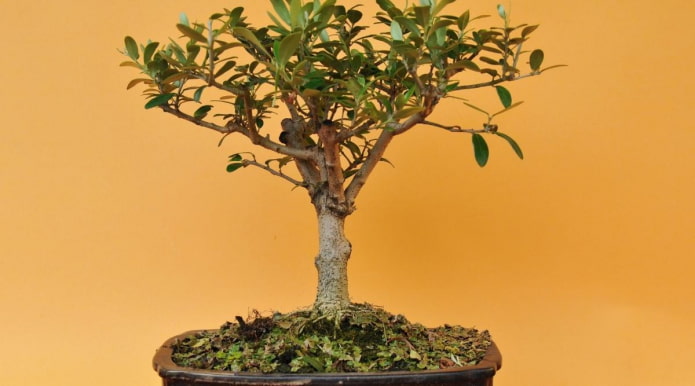
Ficus lyrata
One of the most popular large indoor plants that gardeners love to keep in their homes. It has magnificent evergreen leaves with strong veins that look amazing in any apartment. Ficus prefers bright, filtered light, without direct sunlight.
Water this indoor tree weekly and allow the soil to dry out before watering the plant again. Place the ficus in a location with indirect sunlight. If the conditions are too dark, you will notice slow growth of the ficus.
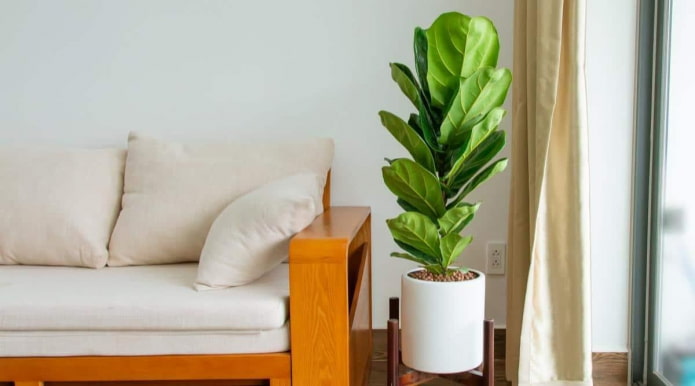
Caryota
The Fishtail Palm gets its name from its decorative fishtail-shaped leaves. To prevent the palm from drying out, it should be sprayed with warm water. In the summer and spring, water the Caryota palm weekly. In the fall and winter, reduce watering to twice a month.
Caryota prefers bright indirect sunlight, as the delicate leaves are prone to burns in direct sunlight. In terms of its whimsicality, it can be compared to Chinese hibiscus, abutilon, fatsia – they differ in appearance, but are identical in care.

Crassula ovata
Crassula is sometimes called the money tree, and botanically it is known as Crassula ovata. This is a remarkable succulent that reaches for the ceiling and brings life to the apartment. Unfortunately, this tree does not actually grow usable currency. Instead, the Crassula grows beautiful jade-green leaves.
The Crassula is one of the most popular low-maintenance plants, they should be watered no more than twice every 7 days, excessive moisture can cause root rot. In winter, water once or twice a month. Place it in a place with plenty of light. Crassulas prefer full sun, but can tolerate partial shade. An alternative to the fat woman is the yucca, which is easy to care for and tolerates rare watering well.

Howea forsteriana
Howea forsteriana is one of the most easy-to-care-for plants that you can add to your collection. This bright indoor palm has bright green leaves that will decorate the room. Water the palm at least once a week. If the soil dries out earlier, water it more often.

Large hanging plants
They look interesting in the interior and do not clutter the floor of the room. These include: hoya, ripsalis, hedera, indoor maple, nepenthes and others. They are hung on the walls, suspended from the ceiling or placed on windowsills. The disadvantages of such specimens are fragile shoots that can be easily accidentally damaged. Below I will tell you about the largest representatives of hanging plants.
Chlorophytum
Chlorophytum comosum forms a mass of arching, grass-like stems that are sabre-shaped and pointed, reaching up to 50 cm (20 in) long and 2.5 cm (1 in) wide. The stems may be entirely green, or green with a broad whitish-cream stripe down the middle, or green in the middle and white at the edges.
Inconspicuous white flowers appear in spring and summer, borne on long, leafless stems (which later give rise to new young plants).
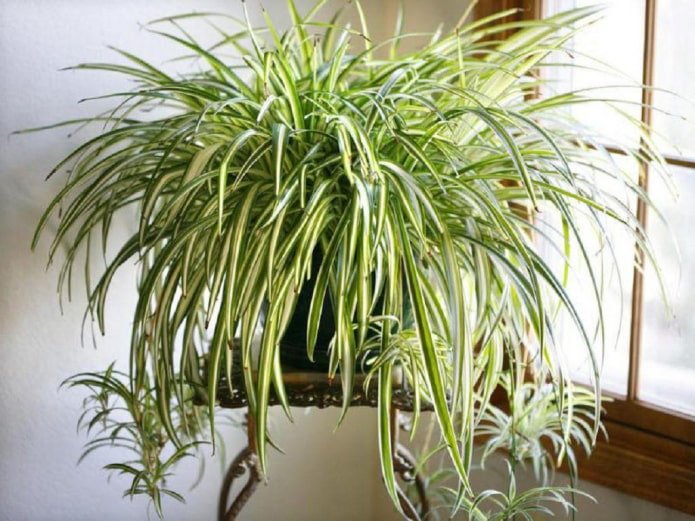
Ceropegia woodii
Ceropegia woodii (lat.) is one of the most popular representatives of ampelous. Its heart-shaped leaves look beautiful. Woodii is available in various colors, including Variegata. This is an undemanding flower, but in order for its foliage to be large and dense on a long stem, it needs a lot of light. It takes root easily, so it can be well compacted.
Just cut off part of the shoot and put it in water, and in a week you will have beautiful cuttings. Ceropegia woodii also pleases with its flowers. It usually blooms in winter. Place it in a bright place, away from direct sunlight. Water when the top layer of soil dries out.

Scindapsus
Scindapsus is a truly beautiful plant that is ideal for a phytowall. Dark green heart-shaped leaves are decorated with a bright silvery sheen. It looks as if it was silvered. It is easy to care for and therefore is often chosen by novice gardeners. It does not like direct sunlight and excess water.
Scindapsus grows quickly and easily takes root in water. It can be kept as a hanging decoration, but it also looks great climbing up a support. It prefers partial shade. Water moderately, as the soil dries out.
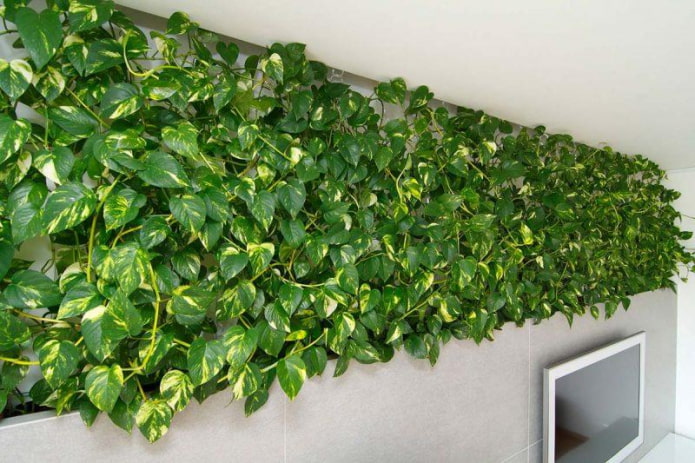
Large and tall indoor plants are the perfect way to fill empty space and bring life and natural color to your home decor. There are many different types, but those mentioned in this list are some of the most enviable options. The next time you are shopping for a new plant to add to your collection, consider purchasing one of these large-sized plants for your indoor garden.
Now reading:
- Discover the All-New Hyundai i10: Compact Excellence
- Piglet ceramic tiles for kitchen backsplash: 60+ ideas and grouting tips
- Handleless Kitchens: 6 Practical Solutions and Their Key Features (32 Photos)
- Grunge style in the interior: key features and ideas with photos.
- Gray Wallpaper for Bedroom: Creative Design Ideas and 70 Inspiring Photos.